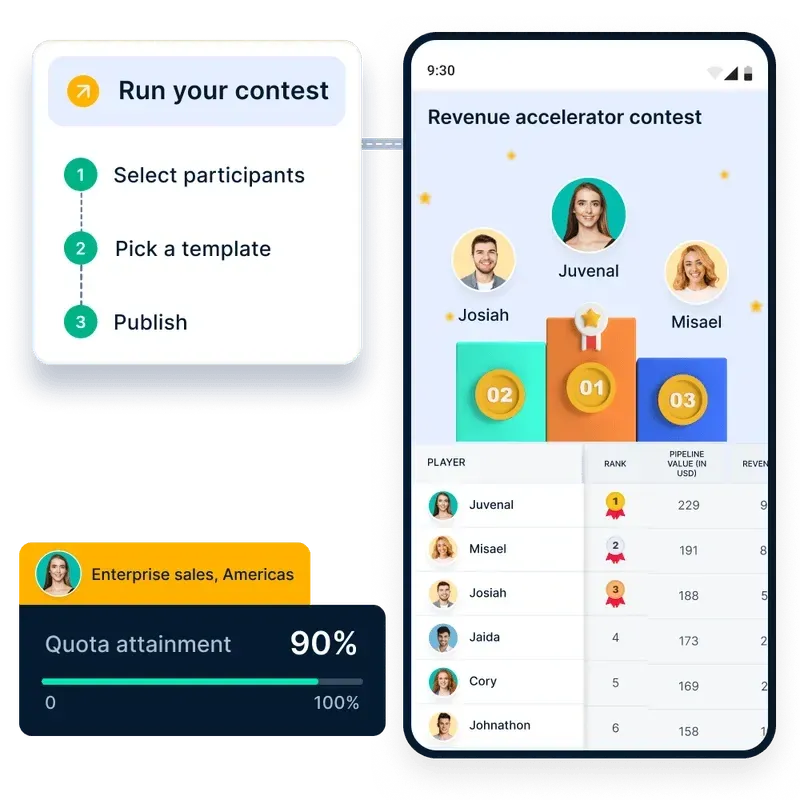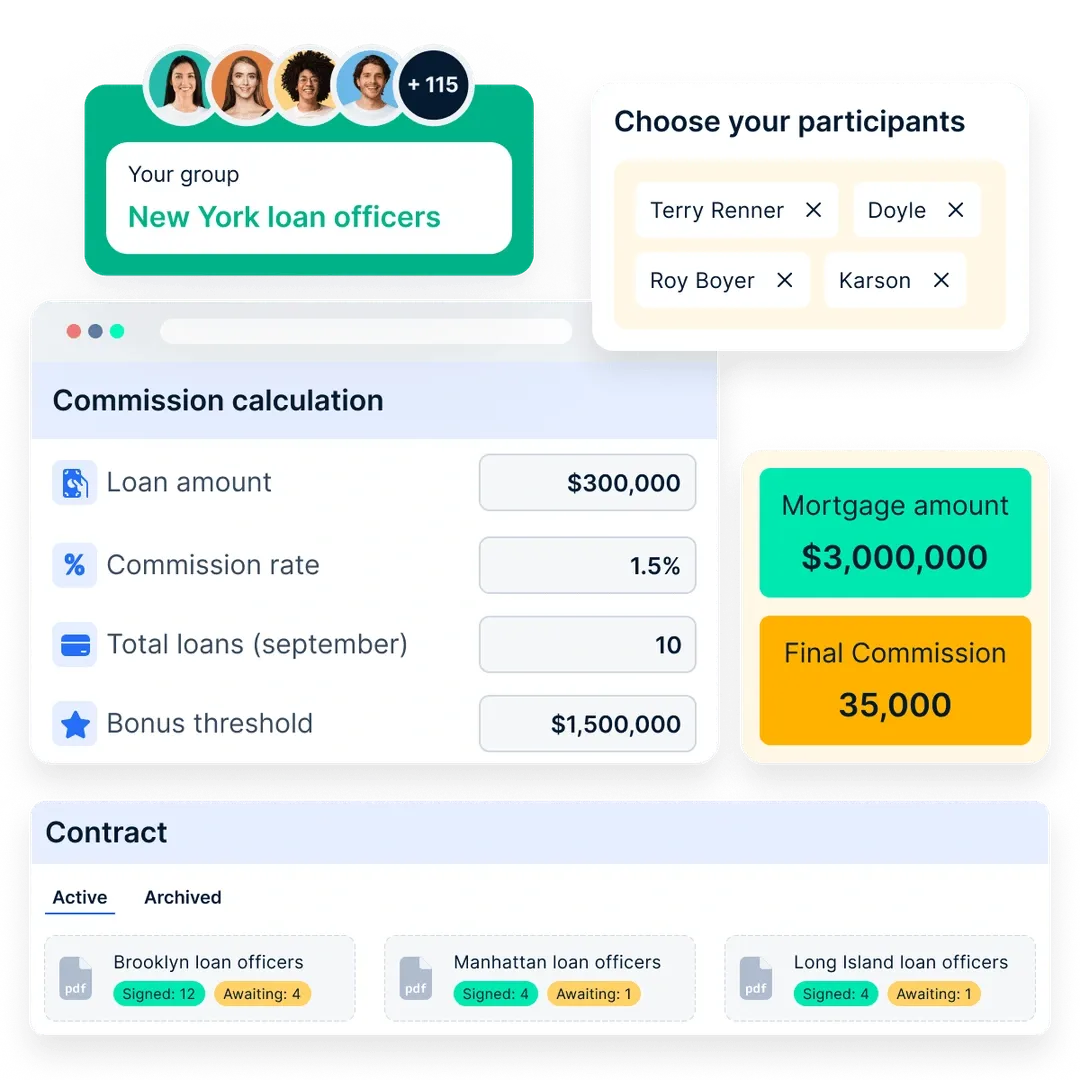Come sviluppare un piano di incentivazione annuale che funzioni: Un approccio strategico
Un piano di incentivazione annuale ben strutturato è più di un semplice bonus: è uno strumento strategico per guidare le prestazioni e allineare i dipendenti agli obiettivi aziendali. Scoprite come progettare un piano di incentivazione annuale che stimoli le prestazioni.
In questa pagina
A research conducted by the Incentive Research Foundation found that organizations with well-designed incentive programs see a 44% boost in worker productivity.
Optimizing sales performance is essential for long-term profitability and growth. Companies have found that implementing annual incentive plans (AIPs) is one successful tactic. These programs are meant to motivate employees, align their work with organizational objectives, and eventually improve sales outcomes.
This article covers the concept of annual incentive plans, including the different types, their advantages, and ideal implementation strategies.
What is an annual incentive plan?
An annual incentive plan (AIP) is a structured compensation program that rewards employees based on their performance over a year. The main goals are to increase productivity, inspire employees to meet targets, and link their efforts with the business's strategic goals.
Although the design of AIPs can vary greatly, they usually include certain goals, a payment structure, and performance measures. Annual incentive plans have two main components, and those are:
- Performance metrics: The standards by which an employee's performance is assessed are known as performance metrics. These could include customer satisfaction ratings, sales goals, or other key performance indicators (KPIs) that are relevant to the goals of the business.
For example, a tech company might use metrics like revenue growth, new customer acquisition, and customer retention rates as performance metrics for the sales team.
- Payout structure: The payout structure outlines how employee incentives are given out. This could be stock options, cash bonuses, or other incentives. To ensure motivation and equality, the structure must be explicit and unambiguous.
For example, Google’s bonus structure includes both financial incentives and stock options to retain talent. To keep talent on staff, Google offers stock options in addition to monetary incentives. The strategy is highly customized to meet the specific demands of your organization and the executives they are trying to attract or retain, rather than being a one-size-fits-all formula.
Difference between an annual incentive plan and an annual bonus
While both an annual incentive plan (AIP) and an annual bonus reward employees for performance, they differ in structure, purpose, and criteria.
In short, AIPs are structured and performance-driven, while annual bonuses are more general, discretionary rewards.
Types of annual incentive plans
Annual Incentive Plans (AIPs) are structured compensation programs designed to reward employees for achieving specific business goals. These incentives not only drive performance but also align individual and team efforts with the company’s strategic objectives. Here’s a closer look at the different types of AIPs and how they function:
1. Revenue-based incentive plan
This plan directly links incentives to revenue generation. Employees, particularly in sales and business development roles, receive bonuses based on meeting or exceeding revenue targets. The goal is to encourage growth and ensure that teams are consistently working toward increasing company earnings.
2. Profit-sharing plan
A profit-sharing model distributes a percentage of the company’s profits among employees. Unlike revenue-based incentives, this plan rewards overall profitability rather than individual sales performance. It fosters a sense of shared responsibility, motivating employees to contribute to cost efficiency and overall financial success.
3. Goal-based incentive plan
Companies often set non-revenue-specific objectives that drive business growth, such as expanding into new markets, improving customer retention, or increasing production efficiency. Employees are rewarded for meeting these predetermined goals, ensuring that business priorities beyond just revenue are addressed.
4. Team performance incentive plan
In environments where collaboration is key, team-based incentives encourage collective performance. Instead of rewarding individuals, bonuses are distributed based on group achievements, ensuring that all team members contribute toward shared objectives. This structure is particularly useful in project-based industries and cross-functional teams.
5. Individual performance-based plan
This type of plan measures and rewards employees based on personal performance metrics. Key performance indicators (KPIs) such as sales quotas, customer satisfaction scores, or project completion rates determine incentive payouts. By focusing on individual achievements, businesses can drive personal accountability and continuous improvement.
6. Discretionary bonus plan
Unlike structured incentive programs, a discretionary bonus is awarded at the company’s discretion. Management evaluates overall contributions, company performance, and exceptional achievements to determine bonuses. Since these bonuses are not fixed, they allow flexibility in recognizing outstanding performance.
7. Tiered incentive plan
A tiered system encourages employees to exceed their basic targets by offering increasing levels of rewards. Employees who meet minimum goals receive a base incentive, while those who surpass expectations qualify for higher payouts. This approach motivates top performers to consistently push their limits.
8. Balanced scorecard plan
A balanced scorecard plan ties incentives to multiple performance indicators rather than a single metric. Employees may be evaluated on revenue generation, customer satisfaction, operational efficiency, and innovation. This ensures a well-rounded approach to performance evaluation, preventing overemphasis on one specific area.
The effectiveness of an annual incentive plan depends on aligning incentives with business goals and employee roles. Some companies implement a combination of these plans to create a well-rounded system that drives motivation and long-term success. A structured, data-driven approach ensures that incentives contribute to both individual growth and overall business performance.
Benefits of implementing annual incentive plans
Here are the 3 main benefits of having an annual incentive plan:
- Increased sales motivation: Annual incentive plans, which offer measurable prizes and specific, attainable goals, greatly increase employee motivation. Employees are more inclined to go above and beyond to meet goals when they are confident that their efforts will be appreciated.
- Alignment with company goals: AIPs assist in coordinating worker actions with the strategic goals of the organization. Employees are more aware of how their work affects the organization as a whole when incentives are tied to certain performance indicators, which guarantees that everyone is aiming for the same objectives.
Employee retention and satisfaction: The satisfaction and retention of employees can be raised by implementing AIPs. Long-term employee retention lowers turnover and promotes a positive workplace culture when workers feel appreciated and rewarded for their contributions.

Reward High Performers with Transparent Incentives
Automate commission payouts and align rewards with sales goals. With Compass, you can motivate your team and improve overall sales effectiveness.
How to design an effective annual incentive plan
An annual incentive plan (AIP) must be more than just a financial reward; it should serve as a strategic tool to drive performance, reinforce key business objectives, and align employee efforts with corporate goals.
Designing an effective plan requires careful structuring to ensure transparency, motivation, and sustainable results. Below is a methodical approach to creating an AIP that delivers measurable impact.
1. Establish clear business objectives
A well-designed AIP should be a direct extension of corporate strategy. The first step is defining what the business aims to achieve over the incentive period. These could be revenue growth, margin improvement, market share expansion, customer retention, or operational efficiency.
Key considerations:
- The objectives must be specific, quantifiable, and time-bound (e.g., "increase revenue by 15% year over year" rather than "improve sales").
- Prioritize a balance of financial and non-financial goals to prevent short-term decision-making at the expense of long-term stability.
- Ensure alignment across departments so that incentives do not drive conflicting behaviors (e.g., aggressive sales targets that compromise customer service).
2. Define the performance metrics that matter
Performance metrics should be precise, measurable, and controllable by the participants. Choosing the wrong metrics can lead to misaligned behaviors that harm long-term business health.
Considerations for selecting metrics:
- Revenue-based metrics: Gross revenue, net revenue, or revenue growth percentage.
- Profitability metrics: EBITDA, operating margin, or contribution margin.
- Productivity metrics: Sales efficiency, revenue per employee, or quota attainment.
- Customer-centric metrics: Retention rate, customer lifetime value (CLV), or net promoter score (NPS).
- Strategic metrics: Expansion into new markets, reduction in cost of acquisition, or innovation KPIs.
Best practices:
- Use a weighted approach. Not all metrics should have equal importance; assign weight based on priority (e.g., 50% on profitability, 30% on growth, 20% on customer retention).
- Ensure line of sight. Participants should be able to see how their individual efforts influence the metrics, avoiding "black box" calculations that undermine trust.
- Incorporate a cap and floor. Set a minimum threshold below which no payout occurs and a maximum cap to prevent excessive, unpredictable payouts.
3. Structure the payout model for maximum impact
The payout structure must motivate performance without introducing excessive risk to the company’s financials.
Common structures:
- Threshold-target-stretch model
- Threshold: The minimum acceptable performance (e.g., 80% of target).
- Target: The expected performance level.
- Stretch: An ambitious but achievable level (e.g., 120% of target) with a premium payout.
- Tiered payouts
- Graduated payments based on levels of achievement (e.g., 5% bonus for 90% of target, 10% for 100%, 15% for 110%).
- Multipliers and accelerators
- Higher incentive percentages for overperformance, which drive exceptional effort.
Key considerations:
- Balance risk and reward. Avoid overly generous payouts that strain profitability or overly restrictive plans that demotivate employees.
- Ensure external competitiveness. Benchmark against market standards to keep incentives compelling.
- Minimize unintended consequences. Ensure payout formulas do not encourage manipulation of revenue timing or excessive risk-taking.
4. Align the incentive plan with role-specific contributions
A one-size-fits-all approach dilutes effectiveness. Tailor the incentive structure based on function-specific KPIs.
- Revenue-generating roles (sales, business development): Revenue growth, deal conversion rates, pipeline velocity.
- Operations and support roles: Efficiency gains, cost savings, process improvement.
- Customer-facing roles (account management, customer success): Retention rates, customer satisfaction scores, cross-sell effectiveness.
- Product and innovation teams: Milestone completion, new product revenue contribution.
Key principle: Keep incentives aligned with what employees can directly influence. For example, a software engineer should not be evaluated based on company revenue but rather on project milestones and product success metrics.
5. Build a transparent communication and tracking system
Even the most well-designed incentive plans fail if employees do not understand how they work. Transparency builds motivation and trust.
Key implementation steps:
- Detailed documentation: Clearly outline eligibility, performance metrics, payout formulas, and timelines.
- Regular progress updates: Implement a real-time dashboard where employees can track their progress.
- Frequent check-ins: Conduct quarterly reviews to reinforce alignment and adjust expectations if necessary.
Avoid these pitfalls:
- Complexity that reduces engagement. Employees should not need a finance degree to understand their incentives.
- Subjectivity in payouts. If employees perceive favoritism or discretionary adjustments, motivation declines.
- Unclear timelines. Define when and how payouts will be distributed (e.g., annually, quarterly with year-end adjustments).
6. Regularly evaluate and refine the plan
AIPs should not remain static. They must evolve alongside the business, market conditions, and workforce expectations.
Annual review considerations:
- Did the plan drive the desired behaviors and business outcomes?
- Were incentive payouts competitive with industry benchmarks?
- Were there any unintended consequences, such as excessive risk-taking or short-term decision-making?
Adjustments might include:
- Rebalancing metric weightings based on company priorities.
- Refining payout tiers to maintain competitiveness.
- Introducing new performance indicators as business strategy evolves.
Power your annual incentive plan with Compass

Managing an Annual Incentive Plan (AIP) can get overwhelming—miscalculations, unclear targets, and delayed payouts can lead to disengaged teams. Compass eliminates these challenges by automating and optimizing your AIP, ensuring seamless execution and motivating employees with transparent, real-time insights.
How Compass transforms AIPs:
- Automated incentive calculations: No more spreadsheets or manual errors. Compass ensures accurate payouts based on predefined performance metrics.
- Customizable plan design: Align incentives with company goals by tailoring structures for different roles and teams.
- Real-time performance tracking: Give employees instant visibility into their progress, driving motivation and accountability.
- Seamless integrations: Sync effortlessly with your CRM and sales tools for accurate, up-to-date performance data.
A well-structured AIP can boost performance, retain top talent, and drive revenue growth—but only if it’s executed right.
Ready to take the guesswork out of incentive management? Try Compass today!
Conclusione
Annual incentive plans are powerful tools for maximizing sales performance and achieving company goals. Businesses may establish incentive programs that encourage employees, match their efforts with organizational goals, and drive corporate success by understanding the essential elements, advantages, and best practices for designing and implementing them, as mentioned in the blog
Domande frequenti
1. What are the key components of an annual incentive plan?
Performance measures, payout schedules, and incentives that are in line with business objectives are the main elements of an annual incentive plan.
2. How do annual incentive plans increase sales motivation?
Annual incentive schemes encourage employees to put in extra effort by setting clear targets and offering tangible incentives for reaching them. This increases sales motivation.
3. What types of performance metrics are commonly used in annual incentive plans?
Sales goals, customer happiness ratings, and other KPIs that are relevant to the organization's goals are examples of common performance measures.
4. How can companies ensure the fairness of their annual incentive plans?
Businesses can guarantee equity by establishing a clear payment structure, outlining the performance evaluation process, and routinely assessing and modifying the plan as necessary.
5. Why is celebrating success important in annual incentive plans?
Rewarding achievements boosts spirits, demonstrates the worth of the incentive program, and inspires employees to keep aiming for greatness.













